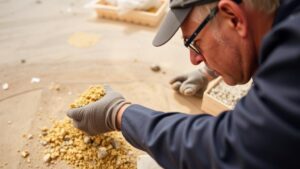How to Identify Hidden Gold Nuggets in Flood Deposits Using Hand Tools
How to Identify Hidden Gold Nuggets in Flood Deposits Using Hand Tools
Gold prospecting is an activity that has captivated individuals for centuries, thanks to the allure of striking it rich. Among the exciting locations for gold prospecting are flood deposits, where natural water flow has moved materials, sometimes exposing valuable minerals like gold. This article provides a comprehensive guide on how to identify hidden gold nuggets in flood deposits using hand tools, aimed at both novices and experienced prospectors.
Understanding Flood Deposits
Flood deposits are layers of sediment that accumulate during the overflow of rivers and streams. e deposits are dynamic, often consisting of coarse materials that shift location based on water force. Floods can carry heavier minerals, such as gold, modifying their positions in the sediment. So, understanding these deposits is crucial for effective prospecting.
Types of Hand Tools for Prospecting
When prospecting in flood deposits, a variety of hand tools can aid in locating gold nuggets. following tools are essential:
- Gold Pans: A shallow, circular pan used to separate gold from sediment through a process involving agitation and water flow.
- Shovels: A standard garden shovel for digging, preferably a small-sized one for portability.
- Trowels: Great for small-scale digging and scraping in specific areas.
- Sluice Boxes: While often larger equipment, smaller hand-operated sluice boxes are effective for separating gold from soil and gravel through water flow.
Identifying Promising Locations
Successfully locating hidden gold nuggets begins with identifying the right locations within flood deposits. Here are some strategies:
- Look for Natural Traps: Gold is dense, often collecting in low spots, behind boulders, or within bends of a riverbed.
- Examine Eroded Banks: These areas can reveal older deposits of sediment that have been exposed by water flow.
- Check the Tail End of Flood Zones: Locations downstream of heavy flooding can accumulate heavy materials, making them prime areas for discovery.
Techniques for Extracting Gold
Once a location is chosen, the extraction process starts. Here are essential techniques:
Using a Gold Pan
Begin by filling a gold pan with sediment from the chosen area. Submerge the pan in water and gently shake it to allow the lighter materials to wash away. This process helps concentrate heavier materials, such as gold, at the bottom of the pan.
Sluicing for Gold
If using a sluice box, set it up in a stream or a place with running water. Pour sediment over the box while the current moves through, trapping gold trapped in riffles or grooves within the sluice. This method is efficient for processing larger amounts of material.
Case Studies: Successful Flood Deposit Prospecting
Numerous successful gold prospecting efforts have resulted from understanding flood deposits. In the Sierra Nevada region, for instance, recreational prospectors have reported finding sizable gold nuggets in areas along river bends after heavy rainfalls. One particularly notable case involved a prospector who discovered a 5-ounce nugget in a flood deposit during a routine pan, leading to further investigation of the floodplain.
Potential Challenges and Considerations
Exploring flood deposits is not without its challenges. Prospective prospectors should consider the following:
- Weather Conditions: Flood-prone areas can be dangerous and should only be approached with caution.
- Legal Access: Ensure you have permission to prospect on the land you choose, as regulations vary by location.
- Tool Limitations: Hand tools require patience and effort; be prepared for extensive manual labor.
Actionable Takeaways
Identifying hidden gold nuggets in flood deposits is a rewarding endeavor that requires the right tools, techniques, and a keen understanding of sedimentary processes. By using the proper hand tools and following the outlined methods and strategies, prospectors can improve their chances of a successful outing. Also, engaging in responsible prospecting by adhering to local regulations will ensure the sustainability of these precious resources for future generations.

